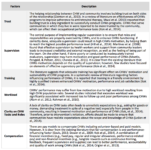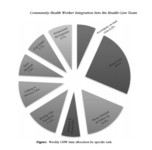Summary of Supervisor Roles
- Establish Work Structure and Assist CHWs in Setting Professional Boundaries
- Mentor CHWs
- Monitor CHWs and Manage Performance
- Ensure CHW Adaptation of Work Culture
- Find the Right Balance of Regarding CHW Autonomy
- Foster CHW Professional Growth and Recognize CHW Work
Best Practices in Community Health Worker Supervision
- CHW supervisors themselves must be provided with adequate support by management. Supervisors should have workloads that allow time to provide regular supervision to CHWs and to address concerns of the CHW as they arise. Training on the CHW model, duties and roles, in addition to CHW supervision may be beneficial to those supervisors new to the role.
- Supervisors should clearly define the CHW role and communicate it throughout the organization. The CHW position should have a clear job description. Both the CHW and other staff should understand the CHW’s role, duties, professional boundaries and reporting structure. When the CHW role is either unclear or not well-communicated, it can lead to a deviation of planned duties and cause frustration among CHWs and other staff.
- Supervisors should mentor and be available to support CHWs. CHWs should provide appropriate mentoring to CHWs to help them overcome challenges, manage their workload, and deal with complex patient cases. These actions can help prevent low morale and protect against CHW burnout. Supervisors should understand both the CHW’s personal as well as professional demands, demonstrate appropriate flexibility and if needed, help CHWs adapt to work culture.
- Supervisors should monitor CHW performance and set reasonable expectations. Supervisors should help CHWs understand the level of demand and commitment required for the job, provide a reasonable workload, help CHWs upload professional boundaries and hold workers accountable. CHWs should be periodically evaluated and provided with constructive feedback on any additional training needs or areas for improvement. Finally, it is recommended that supervisors shadow CHWs in their work both a) to gain a deeper understanding of the CHW’s day-to-day work and b) to evaluate CHW performance.
- Supervisors should provide CHWs with adequate autonomy, recognize their contribution and foster CHW professional development. CHWs play an important role in the intervention and should be treated as full members of the healthcare delivery team. Treating CHWs as such will not only facilitate the recognition of their contribution but will also communicate the value of their position to other staff and community partners.
Sample Supervisor Job Descriptions
Best Practices in Supportive Supervision
Supportive supervision is a type of skilled and reflective supervision. It is designed to foster supportive and collaborative problem solving between the supervisor and the supervisee. The model encourages reflection on one’s own work, acknowledges the emotional intensity of serving others, and encourages a healthy and safe climate for staff. Supportive supervision requires guidance, mentoring, and coaching of CHWs to ensure adherence with practice guidelines and delivery of quality care. Most importantly, supportive supervision calls for teamwork between the supervisor and supervisee to accomplish common goals. In the supportive supervision model, the supervisor creates a supportive environment for the CHW by helping them solve problems, working with them on skills enhancement, and always improving the quality of their daily work activities. Supportive supervision involves acknowledging and addressing the CHW’s workplace stress and concerns. It does not involve providing therapy or getting deeply involved in the personal life of the CHW.
- Establish a regular and protected time for supervision. Finding time communicates to everyone in the system that supervision is critical for our work with children and families. Protecting staff time for reflection encourages individuals to carry the lessons learned through the reflective process into their daily work.
- Share the power. Have an ongoing dialogue with your supervisees about the structure, content, process, timing, and tone of supervision. This offers an opportunity for staff to reflect on what type of supervisory relationship they would like to have and how to negotiate needs together. Ask staff to consider with you how you can work together to respond to a complex situation. This can provide your staff with an opportunity to consider different viewpoints within a system and reinforce teamwork.
- Accentuate the positives among your staff and in the work that they do. Staff need to be reassured about their knowledge and expertise. A non-“top down” approach to supervision gives staff the feeling that they are a valuable member of a team. Staff may feel encouraged to reflect on their own professional competencies and goals.
- Try to listen without judging what your staff is experiencing. How it is affecting their mood, concentration, motivation, ability to connect with others and the demands on you?. What are their emotional reactions to what they experience? Often our own agenda overshadows another’s very real human experience, preventing us from seeing the important pieces of the picture.
- Model healthy ways to manage conflict. By creating a safe and professional space where staff can talk about conflict, you help each other to understand better the roots of problems and strategize about how to address them.
- Make time for reflection inside and outside of supervision. Reflection allows us to consider our reactions, responses and options. Taking time to non-judgmentally consider how effective our response was in a past situation can help prepare us for similar situations in the future.
- Remember that you are not alone. Call on the resources available to you in your agency, community, extended network or your own supervisors. Staff will work more effectively when they have the support that they need, and so will supervisors.
- Establish healthy boundaries. Know your time and content boundaries. This is emotional work, and self-care is essential for you and your supervisee. When you become available to staff in more emotional ways, you will need to take time for yourself to rejuvenate, reflect, and make time for your own supervision and support.
Source: Supportive Supervision: Promoting Staff and Family Growth Through Positive Relationships
Supervision Structures
Supervisors will find it most effective to use multiple formats, including individual supervision, group supervision, and case review/conference style supervision as described in the MA Department of Mental Health’s Supervision Manual. The Massachusetts Department of Public Health recommends that a full-time CHW supervisor should have no more than 7-8 supervisees if she/he is also expected to manage administrative, clinical or fiscal responsibilities. Three different supervision structures are described below.
- Individual Supervision. One-on-one supervision is essential for all staff to discuss performance, challenges, successes, and to provide support for CHWs who are working with diverse clients with varied and profound health and social barriers. CHWs should meet individually 1-2 times a month with their supervisor. Cases need to be reviewed in both individual and group supervision.
- Group Supervision. Group supervision is not an alternative to individual supervision but recommended as a supplement. Groups can be used to inform and coach on programmatic, administrative, and clinical issues. When working through specific cases and scenarios, there is a significant benefit to having peer workers in the room together for team building and mentorship of less experienced CHWs. Some programs use group supervision as a way to increase supportive supervision. For example, a mental health clinician can lead group supervision session in order to offer behavioral health specific support. This role would be an additional supervision position if the CHW supervisor does not have a background in behavioral health.
- Case Reviews/Conferences. These meetings take place with other members of the care team including medical and behavioral health clinicians. The case review model gives CHWs a chance to add to the knowledge and observations about a patient and to articulate their expertise and unique perspective.
The Use of Performance Evaluation Tools To Support Routine Interactive Supervision
At Bronx-Lebanon Hospital, they developed a set of performance evaluation tools to support routine interactive supervision which includes:
- Weekly time assessment by specific task;
- Bimonthly performance enhancement reporting, allowing the CHW [supervisor] to compare weekly CHW time spent per activity, relative to the CHW group average; and
- Quarterly home visit performance evaluation, with the home visit observed by the CHW Administrator or her senior designate.
The home visit evaluation covers the CHW opener or explanation of visit purpose, efforts to build a trusting relationship, and teaching skills. Depending on the specific activity, the CHW Administrator uses the observations to give encouragement and praise where the visit activity was well done and to discuss steps to improve the visit where the activities were less effective. The supportive nature of this performance evaluation has made it well-received, which in turn generally has led to performance improvement. The 3-month evaluation is particularly critical as this is the end of the probation period. Source: Community Health Worker Integration into a Healthcare Team: A Bronx Tale
Determinants of CHW Performance

In one study, six factors were identified for influencing CHW motivation and performance:
- Trust
- Supervision
- Training
- Workload
- Clarity on CHW tasks/roles
- Compensation
Although this research is primarily drawn from CHW program experience overseas and the description reflects international contexts, the six factors are relevant to CHW performance in the US. Source: Minnesota Department of Public Health CHW Toolkit: A Guide for Employers
Determining CHW Workload
A time or task-based analysis can assist employers in determining position workloads and aligning staffing. General practice is also illustrative in determining CHW workload. Some key considerations for workload include:
- Complexity of patient health issues and social needs;
- Number of tasks/focus areas in the program;
- Organization and tools to assist CHW in workload;
- Documentation requirements; and,
- Distance traveled or time needed to travel between clients (especially for home visiting programs)
Workload Example

In their successful integration of Community Health Workers into a Patient-Centered Medical Home, the Bronx-Lebanon Hospital PCMH conducted a CHW time study to in part to educate the Care Team about the time CHW spent working in the community. “Almost half of CHW work is devoted to home visits (25%) and outreach and follow-up (16%), with direct interactions with patients, as shown in the Figure. These interactions allow CHWs to build a trusting relationship and teach self-care and disease management methods. These interactions aim to support the patient’s progression toward achieving their disease management goals as established in their original visit with the CHW. All CHWs are expected to make 2 home visits per day and 3 joint clinic/hospital visits per day. The balance of time is split among additional activities, including writing up case narratives.” Source: Community Health Worker Integration Into the Health Care Team Accomplishes the Triple Aim in a Patient-Centered Medical Home, A Bronx Tale
Clarity of CHW Role Among Entire Team
One of the greatest potential values of CHWs is serving as a bridge between patients and the healthcare team. Numerous articles highlight frequent misunderstanding by doctors, nurses or other care team members about the of CHWs which create barriers to peak performance. Educating the care team about CHW roles supports CHWs to work at the top of their practice.
Supervisors provide guidance as needed to CHWs as they support clients to set and achieve specific goals. A key role of the CHW is ensure that the patient’s own voice is central in guiding the goal-setting process, increasing the likelihood of improved health outcomes.
The Power of Motivational Interviewing
Motivational Interviewing can be a key skill in the community health worker toolkit for supporting clients to set and achieve goals in line with their own motivation. “Health workers regularly encounter people whose behaviors pose serious threats to their health and the health of their loved ones. Motivational Interviewing (MI) is a non-judgmental, non-confrontational, flexible and empathic method of communication to bring about behavior change. In MI the health worker and client establish a collaborative relationship in which the client is empowered to identify his or her own ambivalence about behavior change and enact solutions.” Source: Urban Indian Institute Health Equity Project. Check our calendar to see if a training on motivational interviewing is available soon.
Patient Led Goal Setting
The Penn Center for CHW’s IMPaCT program is one of the most well-developed models for CHW to help patients achieve goals that they have set collaboratively with their provider. It is designed to work within a primary care practice and targets patients with multiple chronic illnesses but can be adapted to other outpatient settings. IMPaCT is built on the science of goal-setting. Most people are better at reaching goals if they are broken down into small steps or short-term goals, so they have a clear path to follow. CHWs can help patients work backwards from a long-term health goal and figure out a roadmap to reaching this goal.

- Set Long-term Goal. CHWs start each intervention by asking patients to choose a long-term health goal that is clear and measurable. This is something that patients can do with the help of their health care provider. The goal can pertain to any setting or health condition: “I want to get my blood pressure down to 140 in the next 6 months,” “I want to stay out of the hospital for the next 6 months,” “I want to get my hemoglobin A1c down to 9 in the next 6 months,” or “I want to lose 15 pounds in the next 6 months.”
 Set Short-term Goal. IMPaCT CHWs then ask the patient what they think they will need to do in order to reach this long-term goal. These are the patient’s short-term goals.
Set Short-term Goal. IMPaCT CHWs then ask the patient what they think they will need to do in order to reach this long-term goal. These are the patient’s short-term goals.- Create a Roadmap. After the CHW helps the patient establish short-term goals that can serve their long-term goal, they help patients figure out how to achieve each short-term goal. They do this by building Roadmaps to each short-term goal. Roadmaps have five components. This table provides more detail on each of these five components:

Another Example of Intervention Protocols
Under the guidance of the CHW Administrator [Supervisor] and with feedback from the CHWs, the CHW care management team at Bronx-Lebanon Hospital links assessment, interactions, and feedback in a cyclical weekly process. The CHW starts with a psychosocial assessment to gauge mental status or mood, openness to change, activities the patient likes and can do, as well as those he/she cannot do. This assessment is the basis for a dialogue with the patient about their strengths and initial steps to move toward overcoming barriers and improving control of their health. The resulting plan is translated into specific activities the CHW can undertake to assist the patient in achieving goals. Each week at care team meetings, progress is reviewed and suggestions for next steps are made. Source: A Bronx Tale
As part of their care management, CHW may:
- incorporate into their home visits counseling, role modeling, and coaching on ways to achieve self-management goals,
- Make phone reminders of appointments or provide an escort service when accompanying patients,
- Facilitate patient-health provider communications,
- Help patients navigate the health system, and
- Work with the hospital social services and partner community organizations to help the patient address social and economic needs.

